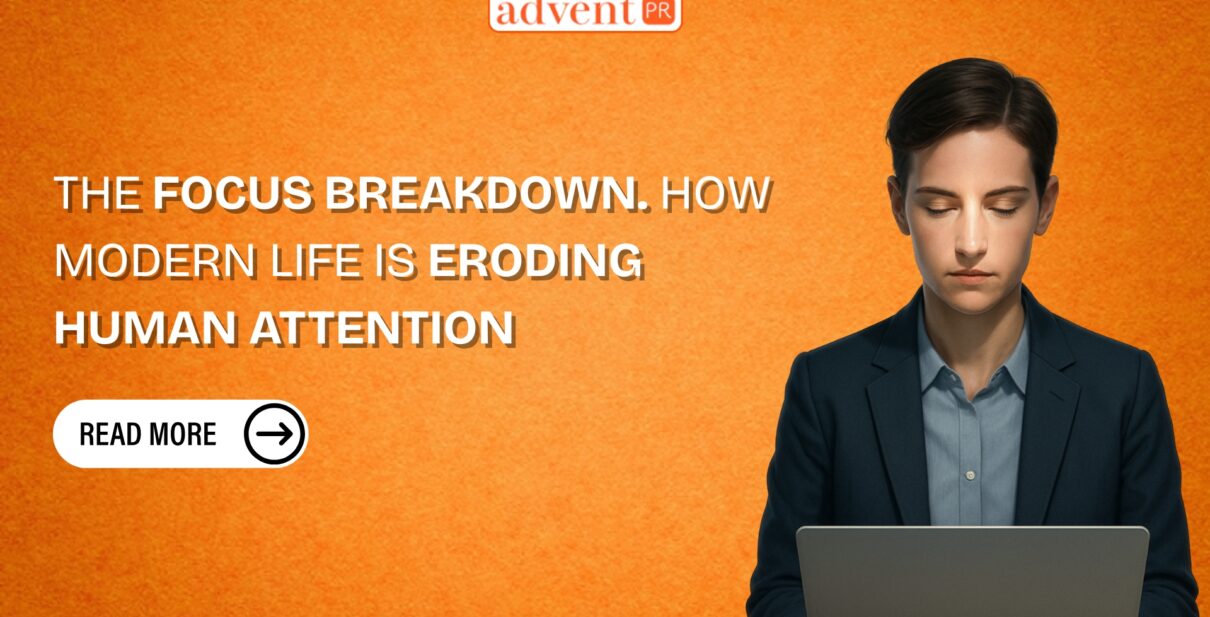The human attention span is now the rarest “currency” that brands and public relations professionals can trade. Being online does not necessarily mean that the audience is more engaged. Engagement rates are going down everywhere – on social media and streaming platforms, as well as brand channels. The structural setback in the consumption of media has been referred to as an “attention recession”.
The daily behaviour metrics used to monitor this situation reveal the magnitude of the problem. The average person divides the time he/she spend on social networks (approximately two hours and twenty minutes) into multiple short sessions, scrolling, and passive consumption. Thus, high aggregate minutes do not guarantee that the sustained, meaningful moments will be achieved, which are essential for PR teams to build the reputation or change perceptions of their clients.
The way in which people consume media is also undergoing changes that make it more difficult for earned media strategies to be successful. Mobile usage keeps on growing and in some markets even surpasses television as the number one source of daily minutes. The mobile-first world we live in nowadays requires that PR narratives be not only reformatted but also shortened to facilitate the creation of more attention-efficient and repeatable touchpoints. Besides that, they should also be prepared for platforms where people consume their content in an intermittent way rather than continuously.
Tools for measurement are also evolving to meet the needs. Industry vendors willingly get on board with creative and attention measurement to demonstrate the connection between the short-form exposure and the longer-term brand outcomes. The new generation of measurement products does this by linking the evaluation of the creative work to brand and sales lift, thus providing communicators with more detailed signals as to what content actually draws attention and which formats lead to conversion. PR teams that are not attentive to these signals risk the production of content that manages to score impressions without moving the audience.
PR’s strategic implications are both immediate and operational on the surface. First of all, the stories have to be purposely designed to attract the attention of the economy. To put it simply, this refers to the first sentence being impactful, a visual-first product being used quietly and automatically, and narrative hooks appearing within three to seven seconds. Secondly, cadence is very important. Instead of doing infrequent long-form outreach, brands should be able to sequence together the micro-experiences in order to build context gradually. Thirdly, the act of measurement should no longer be restricted to counting and instead be directed toward attention-weighted metrics as well as creative diagnostics. Firms that insist on this transformation with their measurement partners will be in a better position to shield the budget and show the effectiveness of their work.
On the tactical side, there is a need for hybridisation in earned media. Journalistic storytelling that combines the credibility of the journalist with the platform-native formats. Collaborations with influencers in which the main currency is sustained storytelling arcs instead of reach. Events that mainly focus on creating memorable moments that can easily be shared. Internal communications should not stay behind and must transform as well because employees are frontline amplifiers whose attention and advocacy have the power to turn micro-engagement into trust, which is of great importance.
The predicament brought by the shortage of attention is not only a crisis but also a chance. The limited availability of something encourages the keeping of strict accounts. Brands that stop broadcasting and start curating moments of genuine relevance will outperform those that chase impressions. PR is to take back its craft. Create fewer messages. Ensure that these messages deserve the short time they are given. Give precedence to the formats and channels that the evidence suggests are most likely to achieve the desired outcome in terms of attention.
As the holders of reputation, communicators have to consider attention as a tangible resource that can be tracked. Employ creative testing. Redirect media and earned efforts to places where they are more likely to be attention-efficient. Deliver the results in terms of attention-weighted metrics, not solely in clips and impressions. The period of quantity metrics is coming to an end. The period of attention-first PR is beginning.





